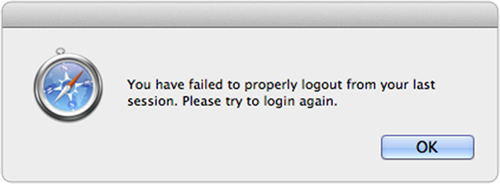User experience (UX) involves a person’s emotions about using a particular product, system, or service.
Today’s consumers have so many options when it comes to choosing the applications they use; applications for staying organized, managing their business, reading books, blogs, news, consuming media, and the list goes on. Apple’s itunes, Google Play, Amazon and others have opened the floodgates of developers who are creating apps of all kinds. The sheer number of available apps has consumers dropping one app for another very quickly and for very little reason. Make a wrong impression through a poorly constructed user experience or lack of attention to detail and you can lose a customer before you even have a chance to get to know them.
This thought came to mind when I recently opened a project management application and received the message below. I know the developers of this app want me to use their solution, but this slight irritation seems like an unneeded step in my experience. And, it’s enough to make me wish for a different, better experience.
In very similar ways, we sometimes stumble over ourselves trying to engage our donors and get them to support our vision. It’s important every now and then for us to take a step back, look inward, and evaluate how we can improve our business processes to create a better experience for donors. Today, I want to take a look at one area that can lead to donor frustration: the donation form.
We have seen time and time again the negative effect added friction in donation forms can cause to conversion rates, gift frequency, average gift rates and even in determining if you get that first gift. When was the last time you made a gift through your organization’s online donation process? Maybe it’s time to take a look at what you are asking donors to do in order to give to your organization. I hope the following questions will help you in evaluating your donation form.
Are you asking for too much information? Long forms that ask for too much information or provide too many options can cause confusion and overwhelm donors when it comes time for them to pull out their credit card. Think about the donation process from your donors’ perspective. Make process decisions based on what will be best for their experience. Keep your payment forms simple and straightforward, and only ask for the information you have to have to begin or continue the relationship. Consider simplifying your designation drop downs. Possibly move business address fields, memorial gift fields, and other information fields to after the payment process or to a separate form altogether.
Is your form pretty? Maybe not pretty, but is the layout clear and uncluttered? Poor design choices can leave a donor confused or questioning the value of their gift.
Are you prefilling forms for your donors? When a donor is directed to a giving form from an email or through the use of a personalized URL, it is very simple to prefill the form to save them time. This also acts as a good way to confirm or obtain updated donor contact information.
What is your call to action? Does your button simple say “Submit?” If so, think about how you feel when someone asks you to submit something. Connecting the wording on your donation form button to the impact the donor’s gift will have engages the donor through the entire process from the case for support through making their gift.
Most important, are you actively testing your donation forms? The only way to truly learn what motivates your donors to give and engage with your organization is through consistently testing all elements of your communications. From form layouts to the headline on your page to button copy to message points to supporting imagery. Running tests will provide you with real data and insight that can dramatically increase results and ultimately make a larger impact in our world.
At the end of the day, it’s all about building the right relationship with your donors. Their experience will play a crucial role in determining whether they are a one time donor or become a long time donor. If you would like help with evaluating your donation process or guidance in developing a testing program to increase donor response, give us a call. We can help.


